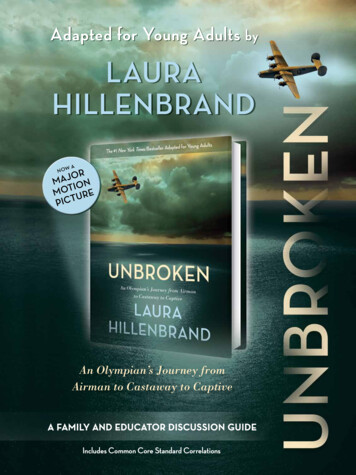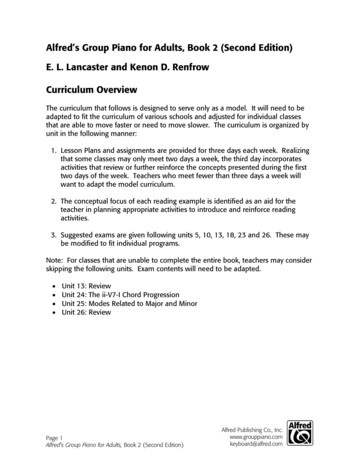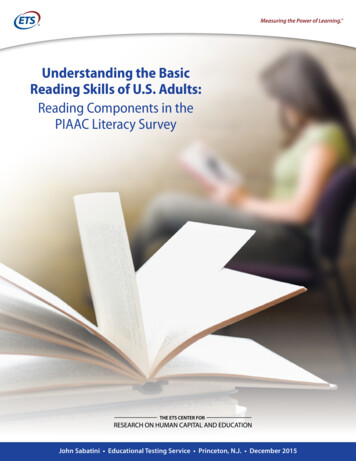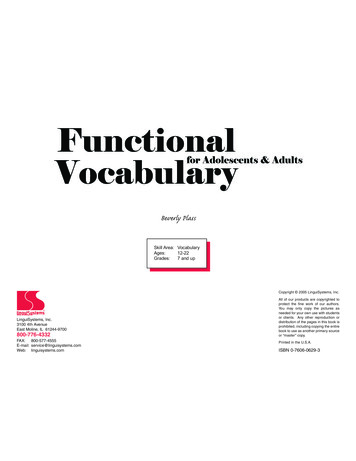
Transcription
Adapted for Young Adults byLAURAHILLENBRANDN OWAORJAM IONMOT UREPI CTAn Olympian’s Journey fromAirman to Castaway to CaptiveA FAMILY AND EDUCATOR DISCUSSION GUIDEIncludes Common Core Standard Correlations
ABOUT UNBROKEN(ADAPTED FOR YOUNG ADULTS)Grades 7 and upHC: 978-0-385-74251-1GLB: 978-0-375-99062-5EL: 978-0-307-97565-2Audio: 978-0-553-39711-6Unbroken is the true account of one man’s journey from juvenile delinquentto 1936 Olympic runner to World War II bombardier. While on a search-andrescue mission, Louis Zamperini’s B-24 bomber crashes in the Pacific Ocean,setting Louie adrift in a life raft for forty-seven days, only to be scooped fromthe ocean by the Japanese. Guards at prison camps, in an attempt to dehumanize their captives, physically torture, starve, enslave, and mentally abuseLouie and his fellow prisoners of war. Through daring acts of resistance, themen fight back, undermined their captors, and maintain their dignity. Afterthe war, Zamperini stumbles through life before finding redemption.Laura Hillenbrand’s account of one young man’s odyssey provides a vividportrait of life as a soldier and prisoner of war (POW) in World War II. Thebook focuses on the role of family, the bonds of friendship, the power of hope,and the will to survive. The author also explores the importance of physicaland mental conditioning in human resilience.ABOUT THE AUTHORLaura Hillenbrand is the author of the #1 New York Times bestsellers Unbroken: AWorld War II Story of Survival, Resilience, and Redemption, and Seabiscuit: An American Legend, which was a finalist for the National Book Critics Circle Award, wonthe Book Sense Book of the Year Award and the William Hill Sports Book of theYear Award, landed on more than fifteen best-of-the-year lists, and inspired thefilm Seabiscuit, which was nominated for seven Academy Awards, including BestPicture. In 2014, Universal Pictures will release the film adaptation of Unbroken,directed by Angelina Jolie. Hillenbrand’s New Yorker article “A Sudden Illness” wonthe 2004 National Magazine Award. Her work has also appeared in such publications as the New York Times, Vanity Fair, the Washington Post, and the Los Angeles Times. She and actorGary Sinise were the cofounders of Operation International Children, a charity that provided schoolsupplies to children through American troops. For more information on Laura Hillenbrand, please visitlaurahillenbrandbooks.com.Author Photo 2001 by H. Darr Beiser/USA TodayTrade PB: 978-0-8129-7449-2HC: 978-1-400-06416-8Audio: 978-1-415-96274-9eBook: 978-0-679-60375-7Unbroken is a powerful informational text, as it tells Louie’s story against thebackdrop of major world events of the twentieth century. Supporting thenational Common Core State Standards (CCSS) in reading informationaltext for middle school and high school curriculums, Unbroken is an appropriate selection for grades seven through ten in Language Arts or U.S. Historyclassrooms.
WHY ADAPT UNBROKEN FOR AYOUNG ADULT AUDIENCE“After the 2010 publication of the adult edition of Unbroken, I was startled by the volume of correspondence I received from teachers, librarians, parents, and students, urging me to recraft the book for youngreaders. The proposal delighted me. For far too long, school instruction on World War II has focused onthe European theater, with little discussion of the Pacific theater. Louie Zamperini’s story offers a uniqueopportunity to take students into the heart of this epic conflict, viewed through the eyes of one American airman, a former Olympic runner, whose 1943 crash into the Pacific began an odyssey that was trulybreathtaking.“And there’s more than just history in this narrative. Zamperini’s story is rich with lessons pertinent toyoung readers—lessons about perseverance, resourcefulness, and ingenuity; maintaining optimism amidstsevere hardship; and ultimately, forgiveness. If ever there was a life to inspire, this one was it.”—Laura HillenbrandWHY READ THE ADULT VERSIONAND THE YA ADAPTATION TOGETHERUnbroken is the perfect selection for a family read. Not only do both the adult and young adult editionsemphasize the importance of family and friendship, they also offer insight into how the power of hope helpsus endure traumatic situations. You can read Unbroken the YA adaptation aloud to each other or individually,using family time to discuss or write about a section read in preparation. Many of the questions and activitiesin this guide for educators can easily be adapted for family use. So let’s get reading!
FAMILY-, SCHOOL-, ANDCOMMUNITY-WIDE READSBoth Unbroken: A World War II Story of Survival, Resilience, and Redemption (adult edition) and Unbroken:An Olympian’s Journey from Airman to Castaway and Captive (young adult edition) are poignant selectionsfor family-, school-, and community-wide reads. In both editions, readers relive the events of Louie’s childhood. They also see Louie’s adolescent interactions with his family and with the residents of Torrance,California. Both editions relate Louie’s experiences as an Olympic runner, a World War II airman, a castaway, and a prisoner of war. The aftermath of Louie’s experiences is explored in both works. World WarII was a pivotal moment in United States history. Through the sacrifices made across this nation by soldiers like Louis Zamperini, and through the dedication on the home front by families like his, this countryemerged on the world theater as a superpower.Using the questions and activities in both the “Unbroken Moments” and the “Discussion and Activity”sections below will further enhance your reading experiences.FOR FAMILIES:“ UNBROKEN MOMENTS”The role of family is an encompassing theme in Unbroken, making the biography a great choice to readtogether as a family. Following is a list of “Unbroken Moments” reflections. These reflections have beenselected to enhance the whole family reading experience about Louie’s life story. As a family, simply choosereflections that promote discussion.2. After Louie is barred from sports and social activities in highschool, his brother Pete goes straight to the principal andintervenes on Louie’s behalf (p. 13). Have you or others inyour family had similar experiences?3. On page 17, we find out that Louie’s mother makes himrunning shorts from a skirt. Louie is coming of age duringthe Great Depression of the 1930s. Are there any familymemories that can be shared of living through theGreat Depression? Do you have family heirlooms, photos,or memorabilia that have been passed down through thegenerations?Louie (left), Virginia, and Pete Zamperini on their front lawn in Torrance,California. Photograph courtesy of Louis Zamperini1. A rambunctious young Louie, upon being reunited with his mother after he jumps off a train, says,“I knew you’d come back” (p. 7). Place your family in this experience. How would each of you react?Does your family have a similar experience?
5. Louie’s mother, Louise, couldn’t stand the suspense of listening to Louie’s Olympic trial run, so she “fled to the kitchen”(p. 26). How do you deal with suspenseful situations?6. Pete sends Louie two playing cards and a “pep talk” messagewhile Louie is at the Berlin Olympics (p. 33). Do you haveany sort of inspirational saying that helps you get throughchallenging times?7. At the NCAA Championships, other runners in Louie’sevent elbow him and stomp on his foot (p. 43). Have youexperienced a similar situation? What was the outcome?8. On page 50, the Zamperinis say goodbye to Louie as he leavesfor the Army Air Force. Has anyone in your family been inthe military especially during a time of war? Discuss.9. In Chapter 7, Louie is the mastermind of a couple of pranks (pp. 62–63). Have you ever pulled aprank on others? What were some of the best ones?10. On page 65, Louie embarks on his first bombing raid of World War II. Do any members of your familyhave any firsthand experiences with or family stories about that war?11. Russell Allen Phillips, Louie’s friend and the pilot of Super Man, carried good-luck charms (p. 77). Doyou have any items or rituals that you carry with you or do for good luck?12. On page 100, the wires that Louie became entangled in when the bomber crashed are “inexplicably”gone. Has your family ever experienced or heard of a miraculous rescue?13. Compare the warning of placing the oxygen mask on yourself first, before you help others in an airtravel emergency, with Louie’s decision to go for the rafts first instead of helping Phil (p. 103).14. Louise’s hands “broke out in weeping sores” (p. 111) after her son was reported missing. Have you oranyone in your family ever experienced a physical reaction resulting from a family emergency?15. While floating on the raft, Louie and Phil talk about various topics–mostly food. They also discusstheir plans for the future (p. 114). What do you think you would talk about? What are your futureplans as a family?16. In Chapter 15, Louie, Phil, and Mac are strafed by the Japanese Zero seven times. None of themis injured. All were instrumental in repairing the remaining raft. What have you accomplishedthrough teamwork?17. On page 126, Louie takes stock of his errors while trying to catch a shark. He is eventuallysuccessful. Have you made mistakes that turned into great learning experiences?Louie lines up for a start. Photograph courtesy of Louis Zamperini4. Louie would lie in the infield before track meets “visualizinghis coming race” (p. 21). What goals have you envisioned foryourself?
18. Hillenbrand writes about dignity, “This self-respect and sense of self-worth, the innermost armamentof the soul, lies at the heart of humanness” (p. 140). Discuss your thoughts about being robbed. Haveyou ever been robbed of your dignity? What was that experience like?19. The Japanese “were taught that to surrender or be captured was intolerably shameful” (p. 150).Compare this ideology with the American psyche and experience.20. Louie keeps a diary in the POW camp (p. 156). Do you know anyone who keeps a diary? Why is itimportant to him or her?21. On page 161, the author explains that the Zamperinis weren’t in denial and they weren’texperiencing hope. “It was belief. They could still feel Louie.” Imagine your family experiencing sucha loss. How might each of you react?23. On page 207, Watanabe says, “You mustbe sincere! You must work for earnest!You must obey! I have spoken!” Whatis your reaction to this command? Haveyou ever had to respond to someone whodemands that you obey?24. When the atomic bombs were droppedon Hiroshima and Nagasaki, the word“atomic” was new to the prisoners ofwar (p. 219). They were not sure what itmeant. Think of words that are new to ustoday. How did these words make it intoour language?25. Try to stop reading momentarily after the last sentence on page 222 (it spills over to page 223). Predict what you think is going to happen to the prisoners based on your experiences so far readingUnbroken. Continue reading. Did you correctly predict the outcome?26. Study the picture on page 229 of the young adult version of Unbroken. It speaks. What is it telling us?27. On page 233, Louie tells a reporter, “If I knew I had to go through those experiences again, I’dkill myself.” Many of the events in Louie’s life came as a surprise. Is the fact that we can’tforetell our future a benefit to us?28. On page 242 of the young adult version of Unbroken, there is a picture of Louie and his familyseated on his parents’ couch after he returns home from war. Does your family have photos of beingtogether? During what events were they taken?29. Louie meets his future wife during a trip to Miami Beach (p. 246). How did your parents meet?How did your grandparents or couples close to you meet?Louie and Pete. Photograph Bettmann/Corbis22. Mutsuhiro Watanabe actually seems to be jealous of Louie (p. 175). Why? How have you workedthrough feelings of jealousy?
30. Louie has a transformational experience at a Billy Graham revival and he dedicates himself to God(p. 268). Have you or has anyone you know had such an experience?31. In Chapter 39, Louie goes back to Japan to offer a message of forgiveness to his former captors.How can it help to offer forgiveness to someone who hasn’t asked for it?32. Once you’ve completed Unbroken, discuss which aspects of Louie’s life most affected you.Was Louie a hero?FOR EDUCATORS:PRE-READING ACTIVITIESINTRODUCTIONBefore reading the introduction to Unbroken, conduct a mini lesson on the main Axis and Allied powersin World War II. Display a map showing Germany, Great Britain, Italy, Japan, and the United States. Inadvance of the lesson, make a list of facts contemporaneous to World War II for each country. Dividestudents into groups of four and ask them to align the Axis powers and the Allied powers. In addition,they can align the facts to each country. You might want to explore the definitions of Imperialism, Nazism,and Fascism.For facts about Japan in World War II, go towww.fold3.com/page/92189068 japan in world war ii/For facts about Nazi Germany, go partyFor facts about Fascist Italy, go tohttp://www.historylearningsite.co.uk/life in fascist italy.htmFor facts about the United States in World War II, go For facts about Great Britain in World War II, go tohttp://www.ducksters.com/history/world war ii/battle of britain.php
DISCUSSION AND ACTIVITY PROMPTSPART IHillenbrand recounts Louie’s bullied youth, his adolescent delinquency, and his transitions from highschool track star to a top-ten Olympic runner and to being drafted by the Army Air Force on the eve ofU.S. involvement in World War II. The author states, “Confident that he was clever and bold enough toescape anything, [Louie] was almost incapable of discouragement” (p. 9).1. How important is confidence and courage when facing crises?2. Compare and contrast Louie’s view of running as something he is forced to do (p. 15) with his selfencouragement, “Let go” (p. 36), while running in the 1936 Berlin Olympics. What constrainedLouie?3. Study the photographs of Louie in Part I.How do they support the personal attributesrevealed in Part I?CURRICULUM CONNECTIONIn Part I, Hillenbrand references events in theworld as she describes Louie’s coming of age. TheGraf Zeppelin world tour, prejudicial treatment ofItalian immigrants in California, Adolf Hitler’s riseto power in Germany, and the practice of eugenics in the United States are a few examples. She also mentions the USS Arizona at Pearl Harbor. Have students, in groups or individually, research these topics and present their findings using electronic media.PART IIIn Part II, Louie and other members of the B-24 Liberator Super Man train in preparation for bombing runson Japanese-controlled Pacific islands.1. In addition to the inherent danger of combat, what problems did airmen encounter aboard theirplanes?2. Discuss Louie’s pranks and his role in saving the crew and the plane after Super Man was hit duringthe Nauru bombing raid. What does this tell you about him?3. Describe the events of Green Hornet’s ill-fated search mission. How did Louie and Phil survive?Photograph Bettmann/Corbis4. Explore Hillenbrand’s use of figurativelanguage [for example, “Passengers . . . saw theship’s shadow, following it on the clouds ‘like ahuge shark’ . . .” (p. 6)]. In what ways does thelanguage enhance the reading experience?
After studying the positions of each soldier aboard SuperMan and Green Hornet (p. 54), have students watcha video clip of a World War II air battle. Give eachstudent a position on the plane. As students experiencethe sights and sounds of World War II air combat, askthem to write stream-of-consciousness poems describingtheir feelings and actions as if aboard a WWII bomberthat is spiraling out of control. What impromptu measures would they take to stay alive/prepare for death?A short video clip of a B-24 in action can be found athttps://www.youtube.com/watch?v lioRCye2Dug.PART IIIPart III is dedicated to Phil, Mac, and Louie’s rubberraft odyssey in the Pacific Ocean. Wounded, Phil cedescommand to Louie. Phil and Louie survive adrift forforty-seven days, shattering a 1942 wartime record bythirteen days.1. Describe the qualities of a good leader. How does Louie demonstrate those qualities?2. In the beginning, Mac was a huge liability. In what ways did he redeem himself? Why and how doyou think he made this transformation?3. Discuss the role of luck or lack of luck up to this point in Unbroken.CURRICULUM CONNECTIONSome say that survival is 80 percent mental (keeping a positive mental attitude), 10 percent skill (knowledge), and 10 percent equipment (specialized resources). See the Montclair College website below for moreinformation.While adrift in the Pacific, Louie takes stock of the rafts’ survival provisions (p. 104). He uses these itemscreatively to save Phil, Mac, and himself (p. 126). Conduct a problem-solving survival scenario usinggroups of four or five. Adapt the sea/wilderness survival experiential learning activities from the websitesbelow to meet the developmental needs of students engaged in the reading of lesson plans/cruisin/lostatsea lesson.html /rdg/gen act/survival/s situation/* Note: The COSEE site above provides for a time line for written analysis—a Common Core State Standards requirement.A last family photograph as Louie leaves to go to war. Rear, left to right: Sylvia’s future husband,Harvey Flammer; Virginia, Sylvia, and Anthony Zamperini. Front: Pete, Louise, and Louie.PHotograph courtesy of Louis ZamperiniCURRICULUM CONNECTION
B- 24 Liberator.PART IVRetrieved from the ocean by enemy Japanese military, Louie and Phil begin two years of internment at Japanese camps. Louie is imprisoned at Kwajalein in the Marshall Islands and in Japan at Ofuna, at Omori, andNaoetsu. The goal of these camps was to devolve prisoners of war into primordial flesh. Sadistic guards physically tortured and mentally abused their captives. Phil was spared execution because Japanese prison officialsbanked on Louie eventually becoming a propaganda prisoner because he was a former Olympian. At home,neither the Zamperini family nor the Allen family validated their beloved’s army-issued death certificates.1. Research and discuss the role of propaganda during WWII in both the Pacific and European theaters.2. Louie and his fellow prisoners of war survived unspeakable torture at the hands of the Japanese. How?3. What role does dignity play in surviving against the odds?4. In the beginning of Part IV, Louie again hears ethereal singing (the first time was on the fortieth dayat sea). Continue to consider the role providence plays in Louie’s survival.5. Discuss the measures the prisoners took to meet their basic needs.6. Discuss the Japanese military mindset. Learning about Japanese intelligence officer Hiroo Onoda athttps://www.youtube.com/watch?v LvT86194rs4 will enhance this discussion.
CURRICULUM CONNECTIONCreate silhouettes for some of the people who had key roles in Louie’s life. Examples of such people areLouie himself, Pete Zamperini, Louise Zamperini, Phil, Mac, William Harris, the Quack, and MutsuhiroWatanabe.1. Have selected students lie on banner paper and trace their outlines.2. Cut the silhouettes out and label them with the students’ names.3. Learn how to write up six-word memoirs at http://www.sixwordmemoirs.com/.4. Have students write six-word memoirs that describe each personality.6. Expand this activity to include key figures inWorld War II by having students research preapproved selections. Suggestions include FranklinDelano Roosevelt, Douglas MacArthur, WinstonChurchill, Emperor Hirohito, Hideki Tojo, andAdolf Hitler.PART VAfter the war, Louie is asked to recount his experiencesin venues across the United States. His resulting anxiety,particularly about having to talk about his experiences infront of crowds, causes him to descend into alcoholismin order to cope. Though he marries the love of his life,it is not enough to resurrect him from debilitating anxiety and his ever-present flashbacks. The marriage frays tothe point of dissolution; then his wife, Cynthia, attendsa revival meeting conducted by Reverend Billy Graham.She insists that Louie attend a meeting with her. He balks but eventually agrees to go. As he listens, sweatdrenched, Louie revisits promises he uttered to God more than once during his times of despair; he revisitsbeing inexplicably spared from certain death. As Hillenbrand writes, “His rage, his humiliation, his helplessness, had fallen away. . . . [He] was a new creation” (p. 269).1. Discuss how Louie’s fellow prisoners of war reacted to the civilian world after their torturouswar experiences.2. Discuss the extent of your sympathy concerning Louie’s actions and reactions in Part V.3. Describe the qualities Cynthia Zamperini possessed that had a profoundly positive impact onLouie’s postwar experiences (a silhouette of Cynthia—and student-driven six-word memoirs—would enhance the reading experience).4. At the end of Part V, discuss the actions that demonstrate that Louie is now a new creation.Louie boarding a training plane in the Army Air Corps. Photograph courtesy of Louis Zamperini5. Display the memoirs on each respective silhouette.
Phil’s crew. Left to right: Phillips, temporary co pilot Gross, Zamperini, Mitchell, Douglas, Pillsbury,and Glassman. Photograph courtesy of Louis ZamperiniCURRICULUM CONNECTIONIn a position paper:1. Analyze the roles that mothers play for Watanabe and Louie. Write a persuasive essay supporting orrefuting each mother’s role.2. Compare and contrast Cynthia’s role in helping Louie find redemption with Pete Zamperini’s role insaving him from the fate of a criminal in his youth.EPILOGUEHillenbrand writes, “Louie spoke of what a wild boy he’d been, and how Pete had rescued him. . . . Pete’seyes opened, and with sudden clarity, rested on the face of his little brother for the last time. He couldn’tspeak, but he was beaming” (p. 279).1. Discuss the role Pete and the rest of the Zamperinis had in shaping the man Louie became.2. Both Louie Zamperini and Mutsuhiro Watanabe survive into old age. Hillenbrand provides adetailed account of prison guard Watanabe’s survival. As you analyze the survival of both Zamperiniand Watanabe, consider the author’s reason for including Watanabe’s account.3. Louie “remained invariably cheerful” into old age (p. 276). Discuss the importance of maintaining apositive attitude even in the face of major challenges.
CURRICULUM CONNECTIONThroughout Unbroken, Louie and others come up with innovations for pranks, for personal survival, andto help others.1. As a class, construct a list of innovations used by Louie and others, paying attention to the purposeof those innovations. Analyze the author’s purpose for including them.2. In student groups, create a Rube Goldberg machine. Have students compare and contrast theirprojects with the innovations in Unbroken. For a detailed Rube Goldberg lesson plan, x.state.al.us/lesson view.php?id 23881IN CONVERSATION1. In this section, Louie describes running as his way of getting recognition. Discuss the role ofrecognition in your life. Is it important? Why or why not?2. Louie also comments on the importance of forgiveness. Consider moments in your life when youhave been wronged. Is it better for you to forgive or to get even?3. Louie says that he would rather consider himself a survivalist than a hero, yet he called Mac a hero.As a group, list the attributes of a survivalist and the attributes of a hero. In which category doesLouis Silvie Zamperini belong?FURTHER STUDY RESOURCESWorld War II W2bib.htmlUnited States, Post–WWII Erahttp://www.digitalhistory.uh.edu/era.cfm?eraID 16Louie reunited with his family. Left to right: Sylvia, Anthony, Louie, Louise, Pete, and Virginia.Photograph courtesy of Louis ZamperiniHistory Matters: The Great Depression and ion find&top1945 1&wwwhist 1
COMMON CORE CORRELATIONSFor a complete listing of the Standards, go to www.corestandards.org/the-standards.HISTORY AND SOCIAL STUDIES, GRADES 6–8Key Ideas and DetailsCCSS.ELA-LITERACY.RH.6–8.2: Determine the central ideas or information of a primary orsecondary source; provide an accurate summary of the source distinct from prior knowledge or opinions.CCSS.ELA-LITERACY.RH.9–10.2: Determine the central ideas or information of a primary orsecondary source; provide an accurate summary of how key events or ideas develop over the course of thetext.CCSS.ELA-LITERACY.RH.6–8.3: Identify key steps in a text’s description of a process related tohistory/social studies (e.g., how a bill becomes a law, how interest rates are raised or lowered).CCSS.ELA-LITERACY.RH.9–10.3: Analyze in detail a series of events described in a text;determine whether earlier events caused later ones or simply preceded them.Craft and StructureCCSS.ELA-LITERACY.RH.6–8.4: Determine the meaning of words and phrases as they are used ina text, including vocabulary specific to domains related to history/social studies.CCSS.ELA-LITERACY.RH.9–10.4: Determine the meaning of words and phrases as they are usedin a text, including vocabulary describing political, social, or economic aspects of history/social science.CCSS.ELA-LITERACY.RH.6–8.5: Describe how a text presents information (e.g., sequentially,comparatively, casually).CCSS.ELA-LITERACY.RH.9–10.5: Analyze how a text uses structure to emphasize key points oradvance an explanation or analysis.CCSS.ELA-LITERACY.RH.6–8.6: Identify aspects of a text that reveal an author’s point of view orpurpose (e.g., loaded language, inclusion, or avoidance of particular facts).Integration of Knowledge and IdeasCCSS.ELA-LITERACY.RH.6–8.7: Integrate visual information (e.g., in charts, graphs,photographs, videos, or maps) with other information in print and digital texts.CCSS.ELA-LITERACY.RH.6–8.8: Distinguish among fact, opinion, and reasoned judgmentin a text.
HISTORY/SOCIAL STUDIES, SCIENCE & TECHNICAL SUBJECTS WRITINGText Types and PurposesCCSS.ELA-LITERACY.WHST.6 – 8.1 and CCSS.ELA-LITERACY.WHST.9–10.1:Write arguments focused on discipline-specific content.CCSS.ELA-LITERACY.WHST.6 – 8.2 and CCSS.ELA-LITERACY.WHST.9–10.2:Write informative/explanatory texts, including the narration of historical events, scientific procedures/experiments, or technical processes.Production and Distribution of WritingCCSS.ELA-LITERACY.WHST.6–8.4 and CCSS.ELA-LITERACY.WHST.9–10.4: Produce clearand coherent writing in which the development, organization, and style are appropriate to task, purpose,and audience.CCSS.ELA-LITERACY.WHST.6–8.6: Use technology, including the Internet, to produce andpublish writing and present the relationships between information and ideas clearly and efficiently.CCSS.ELA-LITERACY.WHST.9–10.6: Use technology, including the Internet, to produce,publish, and update individual or shared writing products, taking advantage of technology’s capacity tolink to other information and to display information flexibly and dynamically.Research to Build and Present KnowledgeCCSS.ELA-LITERACY.WHST.6–8.7: Conduct short research projects to answer a question(including a self-generated question), drawing on several sources and generating additional related, focusedquestions that allow for multiple avenues of exploration.CCSS.ELA-LITERACY.WHST.9–10.7: Conduct short as well as more sustained research projects toanswer a question (including a self-generated question) or solve a problem; narrow or broaden the inquirywhen appropriate; synthesize multiple sources on the subject, demonstrating understanding of the subjectunder investigation.CCSS.ELA-LITERACY.WHST.6 – 8.9 and CCSS.ELA-LITERACY.WHST.9–10.9:Draw evidence from informational texts to support analysis, reflection, and research.
READ IT BEFORE YOU SEE IT!Unbroken is now a major motion picture. The movie follows closely the events in the book. Therefore,many of the themes presented in the book get equal treatment in the movie adaptation. Themes ofsurvival, resilience, and hope are powerfully rendered in the movie. Like readers of the adult and youngadult books, movie watchers will be able to analyze the characteristics and conditioning needed tosimply survive dire situations versus the characteristics and conditioning needed to survive as a hero.Reading the book prior to watching the movie will allow participants to compare and contrast the effectof the written word with that of visual media in communicating the many powerful messages the author,Laura Hillenbrand, conveys in Unbroken. So read the book, then watch the movie!This guide was created by Judith Turner, a longtime educator at Terrace Community Middle School in Tampa, Florida. She has a BA in Literature andLanguage from the University of Wisconsin–Green Bay and an MA in Educational Leadership and Policy Studies from the University of South Florida.Random House Children’s Books School and Library Marketing 1745 Broadway New York, NY 10019 11/14RHTeachersLibrarians.comPhotograph of ocean and sky 2014 by Joel Sartore/National Geographic Stock Photograph of plane 2014 by Getty Images/123RF
YOUNG ADULT AUDIENCE “After the 2010 publication of the adult edition of Unbroken, I was startled by the volume of correspon-dence I received from teachers, librarians, parents, and students, urging me to recraft the book for young readers. The proposal delighted me. For far to










